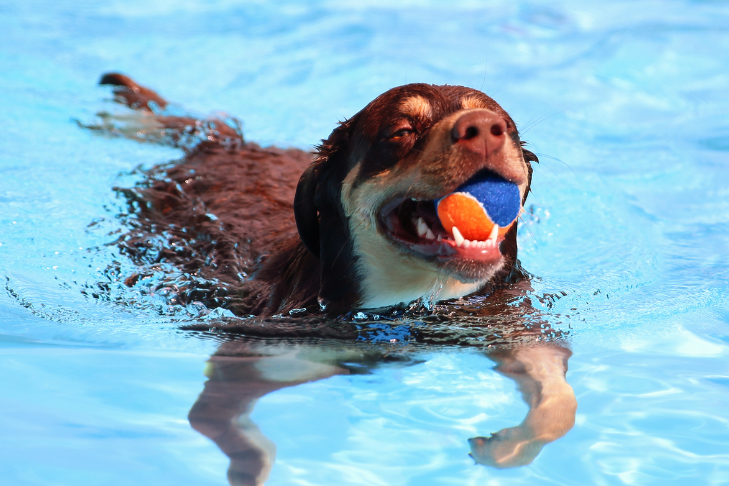Can All Dogs Swim? Tips for Safely Teaching Your Pup How to Swim

By Stephanie Gibeault, MSc, CPDT
You might think dogs take to swimming like ducks to water. After all, they even have a swimming stroke named after them – the doggy paddle. Well, if you have a breed like a Labrador Retriever or Nova Scotia Duck Tolling Retriever, that’s probably the case. In fact, breeds like these were designed to work in the waves. Swimming is literally in their genes. But for many other dogs, swimming doesn’t come naturally. They might need help learning to navigate the pool or lake, or their body shape might make swimming without a life jacket next to impossible.
Natural Born Swimmers
Natural-born swimmers are built for the task with long, strong back legs. Some even have waterproof coats and webbed feet. These dogs are often from breeds with water in their background. Think about the Portuguese Water Dog who was once a fisher’s best friend. They worked in the water herding fish into nets and carrying messages between the shore and the ship. Or how about the American Water Spaniel who was developed to help hunters in the waterways around the Great Lakes. These dogs were purpose-bred for swimming, so it’s no wonder they seem to be born knowing how to get around in the water.
If you have a water-loving breed, or a mutt with such breeds in their mix, they will probably be a natural swimmer. But don’t make that assumption. No matter their heritage, some supposed water dogs are awkward or uncomfortable in the water. Try the tips below for water-shy dogs to help your pup find their confidence. And never toss your dog into deep water and hope for the best, no matter what their heritage. Dogs can drown. Or the trauma can turn into a lifelong fear of the water. It’s much better to take it slow and start in shallow water.
Dogs Who Need Swimming Lessons
Many dogs are physically capable of swimming but need help getting the hang of it. Without assistance, they can easily become overwhelmed or anxious. If they panic or exhaust themselves with frantic paddling, it’s a serious safety risk. In the beginning, these dogs benefit greatly from a life jacket. It gives them confidence in the water and allows them to figure out they can paddle with all four feet. It also helps if you enter the water with your dog. Encourage them and reward them for every step forward, even if it’s just getting their paws wet. But be sure to wear your own life jacket. If your dog gets scared or tries to climb you, you can be pulled under the water. Finally, consider letting your novice swimmer play with a more experienced dog in the water. If their companion is a strong, confident swimmer, your life-jacket-wearing pup can learn a lot by observation. It will also inspire them to get wet and have fun.

Dogs Not Made for the Water
Finally, there are dogs who struggle to swim because their bodies aren’t designed for the water. This may be due to their legs, their torsos, their faces, or their coats. First, dogs with short legs, like Basset Hounds, have a hard time paddling hard and fast enough to stay afloat. Second, pups with long, barrel-shaped bodies, like Bull Terriers, don’t float well. Third, dogs with flat faces, like Pugs, find it difficult to keep their noses in the air. They can inhale water too easily as they try to keep their head up. Finally, a long, heavy coat, like that of a Chow Chow, can drag a dog down so they have to work even harder to keep afloat.
Some other breeds that have difficulty swimming are Dachshunds, Bulldogs, and Corgis. Think about their shapes. They are all long and barrel-shaped with short legs. And the bulldog has a pushed-in muzzle to boot. It’s dangerous to expect them to swim without a properly fitting life jacket to keep them afloat and their head above water.
Of course, every dog is an individual. Some Bulldogs love the water, and some Labs can’t float. Remember, it’s okay if your dog never learns to swim. They can still enjoy playing in the shallows or romping on the beach. Or fill their very own kiddie pool with water and let them splash the day away. Just follow your dog’s lead and always put safety first so your dog can enjoy the water in their own way.
***
Swimming can be a great therapeutic activity for senior dogs and dogs with other mobility issues. Paired with Hip & Joint Releaf and SENTESA, low-impact activity can help improve your dog’s overall joint health.





